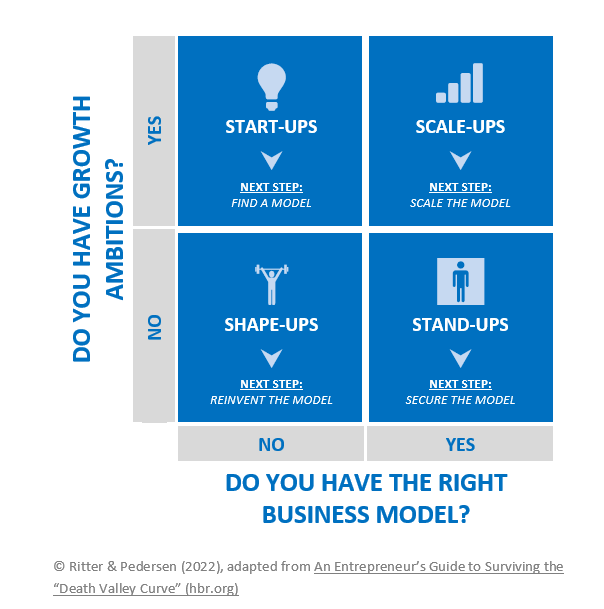How to survive and prosper: Matrix gets new businesses through the Death Valley Curve

Illustration: Thomas Ritter and Carsten Lund Pedersen.
Making the right decisions for a new venture to prosper centres on recognising which stage the business has reached. Researchers at CBS created a matrix that helps ventures define where they are on their path to success – or failure.
The Death Valley Curve definitely does not sound like somewhere you would want to be stuck for too long.
Particularly new businesses, since the Death Valley Curve describes a stage where the business has spent all its initial funding but is still not making a profit. Many new businesses never make it past this point.
To help new businesses navigate through the Death Valley Curve and prosper on the other side, Thomas Ritter, professor at CBS, and Carsten Lund Pedersen, formerly CBS and now associate professor at the IT University of Copenhagen, have developed a two-by-two matrix recently featured in an article in Harvard Business Review.
However, the matrix was initially created for a very local and simple reason:
“We initially created the matrix for a programme for start-up boards at CBS. We know that a lot of bad decisions are made especially in new ventures, since they don’t realise where they are on their development path. We needed course materials to help enlighten them and tossed different ideas back and forth until we found the right structure for the matrix. We are rather fond of the two-by-two format, as it is very simple, but if used correctly, should be fully comprehensive,” explains Thomas Ritter, professor at the Department of Strategy and Innovation at CBS.

Carsten Lund Pedersen, who was working at CBS when the two researchers developed the matrix, expands:
“You could say that the matrix was born out of frustration because the terms related to new businesses are very fluffy. We wanted to create a structure to help new businesses understand the different stages of a company’s journey.”
Two questions determine the stage of your business
To use the matrix, you “just” have to answer two questions: Does your business have growth ambitions? And do you have the right business model?
“Of course, all companies have some sort of growth ambition in the sense that they want to be able to pay their bills and staff wages, but there is a difference between that and wanting to expand your company on a larger scale,” says Thomas Ritter.

Similarly, a company might have written down a business plan, but if it has not yet proven successful or is outdated, then the two researchers would say that a company has not yet found the right business model.
“When speaking to students at CBS, we often find they don’t have well-proven business models, but there is nothing wrong with their ambitions,” Carsten Lund Pedersen says.
The two researchers have also found that the matrix seems very intuitive during tests.
“Both the students on our courses as well as founders and investors we have talked with seem able to place themselves relatively easily in one of the four corners,” says Thomas Ritter.

Four different company stages
The matrix divides companies into four categories: start-ups, scale-ups, shape-ups, and stand-ups.
A start-up is defined as a company that is still searching for the right business model, trying out different approaches to see what works and what fails, and constantly changing to see what is most profitable for it.
A scale-up is defined as a business with a solid business model and growth ambitions.
“It is important to have the right business model before scaling your business. Otherwise, you will start scaling a business that might not be profitable. The TV show Dragons’ Den (Løvernes Hule in Danish) neatly illustrates the difference. The dragons usually sidestep start-ups that have not yet found the right business model. They are more interested in scale-ups where they can help them on the journey towards expansion,” says Thomas Ritter.
We know that a lot of bad decisions are made especially by new ventures, since they don’t realise where they are on their development path.
Thomas Ritter, professor at the Department of Strategy and Innovation at CBS
A shape-up is a business that might have reached its growth ambitions but where the market has changed, or new competitors are taking large chunks of its market.
In the article, Thomas Ritter and Carsten Lund Pedersen describe how personal digital assistants were unnecessary after smartphones became household items.
These companies need to come up with a new business model to be profitable again.
The last type of business is the stand-up. Stand-ups are out of danger from the Death Valley Curve for now, but still need to keep securing their business model.
As Carsten Lund Pedersen explains:
“A company will hopefully move from the start-up stage to one or more of the others. Facebook, for instance, has virtually passed through all the stages. It began as a start-up searching for the right business model, then it became a scale-up, trying to grow its business. Then it evolved into a stand-up, trying to ensure continued operations, and now you might describe it as a shape-up, since there has been a lot of debate about its business model lately and it might have to reinvent itself.”
Take action based on the stage your business has reached
The two researchers stress that figuring out where your business is on the matrix is not enough.
You need to act accordingly and, very importantly, you must make sure there is alignment between the company’s stakeholders.
“If the board of a company thinks you are at one stage, but the founders believe it is at another, they will have very different views on how money should be spent. It is therefore very important to have this open talk and make sure that everyone is aligned. This will also ensure that you are working together to find the right path forward,” says Carsten Lund Pedersen.
The researchers believe that the matrix is also relevant even for companies beyond the shadow of the Death Valley Curve.
“Established businesses will also be able to identify their position in the matrix, or parts of their business can be positioned, and hopefully knowing which stage they are at will help them move forward,” says Thomas Ritter.






































































































































Comments